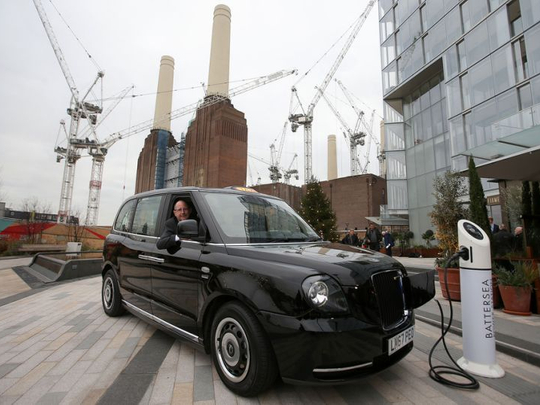
You may have seen or heard about Dubai's fully-electric airport limos and its growing hybrid taxi fleet.
Now, it's London's turn. The iconic black cab is getting a cleaner sibling as the British capital rolls out its first electric-powered taxis.
London's first EV black cabs hit the streets on Tuesday, with the iconic taxis getting a facelift for the modern age.
London's first electric-powered black cabs hit the streets with a face-lift for the modern age that should help cut pollution in the city https://t.co/HqO87A5bcf pic.twitter.com/Dm9MoGSAq9
— AFP news agency (@AFP) December 5, 2017
The new-look cabs will meet the strict new emissions regulations required for all new London taxis from 2018.
Replacing diesel taxis
They are replacing the old diesel cabs, with more than 9,000 electric taxis — around half the current fleet size — expected to be plying for trade by 2021.
"The vehicle is totally new from the ground up and it's a much better experience both for the cabbie and the passengers," Chris Gubbey, chief executive of the London Electric Vehicle Company, told AFP.
"The ride and handling is much better and it's very quiet.
"It's marrying all of the cutting edge technology with vast experience of what it takes to make a good taxi."
The renamed London Taxi Company has been making London's black cabs for almost 70 years in Coventry, central England.
The manufacturer was rescued from administration in 2013 by Chinese automaker Geely.
The new cabs retain much of the familiar shape, but are marginally bigger, allowing a sixth passenger inside.
The taxis have been brought up to date with wifi, USB chargers, a plug socket and a contactless payment card reader in the back.
The new, transparent roof allows passengers to take in the cityscape above them.
- Smooth and silent -
"The ride quality is unbelievable. Customers are going to love it. It's so smooth and quiet," said Peter Powell, 61, a London cab driver of 22 years, who been road testing the new taxis for the past two months.
But he admitted that "a lot of old guys don't like the change" with some concerned about a dearth of charging points.
The new TX eCity taxi costs £55,000 ($73,800, 62,400 euros), compared to £45,000 for the last diesel TX4s.
£100/week in fuel cost savings
However, manufacturers estimate cabbies could save £100 a week in fuel costs.
While Powell and a few other drivers have been road-testing the new taxi in London, it has also been put through its paces in the extreme conditions of the Arctic and Arizona.
London taxi drivers average 120 miles (195 kilometres) per day, including their commute to and from work.
The new taxi can do 80 miles on electric power, and has a range-extender petrol engine that runs a generator, meaning it can cover up to 377 miles, always on electric power.
It is different from many hybrid vehicles currently on the road in that the petrol engine does not drive the wheels directly.
The new taxi produces about 10 percent of the carbon dioxide emitted by the TX4 and its nitrous oxide emissions are close to zero.
They can repower in 35 minutes at rapid charging stations.












